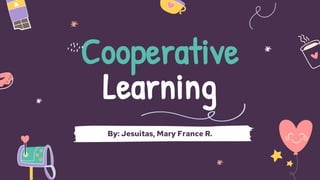
Cooperative Learning
- 1. Cooperative Learning By: Jesuitas, Mary France R.
- 2. 01 Table of Contents Research Evidences Advantages and Disadvantages 03 Five Elements of Cooperative Learning inside the classroom Differentiate Cooperation vs. Competition vs. Individualistic Efforts 04 Different Techniques that can be employed inside the classroom 02
- 3. Educational approach which aims to organize classroom activities into academic and social learning experiences Positive interdependence Demanding, Creative, Open-ended, and involve Higher Order Thinking Tasks (Ross & Smyth, 1995) What is Cooperative Learning?
- 4. Why use Cooperative Learning?
- 5. FIVE ELEMENTS of Cooperative Learning 01
- 6. FIVE ELEMENTS OF COOPERATIVE LEARNING POSITIVE INTERDEPENDENCE FACE-TO-FACE INTERACTION GROUP PROCESSING INDIVIDUAL AND GROUP ACCOUNTABILITY INTERPERSONAL AND SMALL GROUP SKILLS 01 02 03 04 05
- 7. 01 IS MY GAIN YOUR GAIN? I CAN'T DO IT WITHOUT YOU. SWIM OR SINK TOGETHER?
- 8. 02 PROMOTE EACH OTHER SUCCESS WE WORK WITH A PARTNER OR AS A TEAM I NEED YOUR HELP AND YOU NEED MY HELP
- 9. 03 NO HITCHHIKING! NO SOCIAL LOAFING! AM I DOING MY PART? ARE YOU DOING YOUR PART? I'M GOING TO DEMONSTRATE WHAT I KNOW!
- 10. 04 SOCIAL SKILL MUST BE TAUGHT WE ARE ALL PARTICIPATING SOME ARE LISTENING; SOME ARE SPEAKING SOME GET TO RECITE; OTHERS GET TO COACH SOMETIMES WE ALL ARE DOING PART OF AN ACTIVITY AT THE SAME TIME.
- 11. 04 SKILLS ALSO INCLUDES: effective communication, interpersonal and group skills: 4. Friendship- development 5. Communication 6. Conflict-management skills 1. Leadership 2. Decision-making 3. Trust-building
- 12. 05 GROUP DECISION: CHANGE OR CONTINUE THAT BEHAVIOUR? Reflect on which member actions were helpful Make decision about which actions to continue or change
- 13. DIFFERENT TECHNIQUES 02 that can be used inside the classroom
- 14. Cooperative-learning techniques revolve around the use of a particular tool. SMALL GROUPS It can be used with almost any educational strategy How to use Cooperative Learning?
- 15. TECHNIQUES THINK-PAIR-SHARE 01 Developed by: Frank T. Lyman in 1981 Allows for students to contemplate a posed question or problem silently Individuals think, then pair up and then share their responses
- 16. TECHNIQUES JIGSAW 02 Students are members of two groups: home group and expert group Each member of five or six member heterogeneous group is responsible for mastering a portion of the material and then teaching that part to the other team members.
- 17. TECHNIQUES JIGSAW II 03 Developed by: Robert Slavin in 1980 Members of the home group are assigned the same material, but focus on separate portions of the material.
- 18. TECHNIQUES REVERSE JIGSAW 04 Developed by: Timothy Hedeen in 2003 Students in the expert groups teach the whole class rather than return to their home groups to teach the content.
- 19. TECHNIQUES INSIDE-OUTSIDE CIRCLE 05 Students form two concentric circles and take turns on rotation to face new partners to answer or discuss the teacher’s questions
- 20. TECHNIQUES RECIPROCAL TEACHING 06 Developed by: Brown & Paliscar in 1982 Allows for student pairs to participate in a dialogue about text. Partners take turns reading and asking questions of each other, receiving immediate feedback
- 21. TECHNIQUES THE WILLIAMS 07 Students collaborate to answer a big question Each group has differentiated questions that increases in cognitive ability to allow students to progress and meet the learning objective
- 22. TECHNIQUES STAD 08 Student-Teams-Achievement Divisions Students are placed in small groups (or teams). Students in heterogeneous groups of four to five members use study devices to master academic material and then help each other learn the material through tutoring, quizzing and team discussions
- 23. TECHNIQUES RALLY TABLE 09 Written version of Robin Table Students are divided into groups.
- 24. TECHNIQUES TGT 10 TEAM GAME TOURNAMENT Students are placed into small groups to study and prepare for a trivia game.
- 25. RESEARCH EVIDENCE Advantages and Disadvantages 03
- 26. Research on cooperative learning demonstrated “overwhelmingly positive” results Students demonstrate academic achievement Cooperative learning methods are usually equally effective for all ability levels Cooperative learning is effective for all ethnic groups Student perceptions of one another is enhanced when given the opportunity to work with one another Cooperative learning increases self-esteem and self-concept Ethnic and physically/mentally handicapped barriers are broken down allowing for positive interactions and friendships to occur ADVANTAGES
- 27. Teachers may become confused and lack complete understanding of the method Teachers can get into the habit of relying on cooperative learning as a way to keep students busy Teachers may also be challenged with resistance and hostility from students who believe that they are being held back by their slower teammates DISADVANTAGES
- 28. DIFFERENTIATION 04 Cooperation vs. Competition vs. Individualistic Efforts
- 29. Cooperation vs. Competition vs. Individualistic COOPERATION COMPETITION INDIVIDUALISTIC students work against each other to achieve a good grade and only some of them succeed students work independently to achieve learning goals unrelated to those of other students students work and discover a new concept together as well as helping each other to learn
- 30. Resources Cooperative Learning. Retrieved January 12, 2021 from https://www.slideshare.net/ahmedabbas1121/cooperative- learning-62463910 Differences Among Cooperative, Competitive, and Individualistic Learning. Retrieved January 13, 2021 from https://intime.uni.edu/differences-among-cooperative-competitive-and-individualistic-learning Gallagher, M. (2017). Educational Technology for Teaching and Learning. New York: Library Press
- 31. THANK YOU!